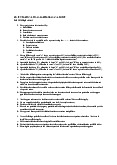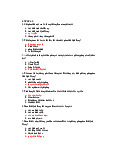



Preview text:
Contributor: C. Yarnoff, Writing Program, csy771@northwestern.edu Posted: 2009
Comments: I distribute this handout the class period that precedes the due date for the
first draft of an analytical essay on Margaret Atwood’s novel, The Handmaid’s Tale. As
preparation for the discussion of the handout, I assign students to write a tentative thesis
for their draft and to read a freshman seminar award-winning analytical essay (available
on the Writing Place website-- http://www.writing.northwestern.edu/awards.html). I talk
through the handout briefly and then ask students to review one another’s tentative thesis
statements and make suggestions as needed.
Tips for Writing Clear, Persuasive Analytical Essays
Several examples in this handout come from the paper I distributed, “Character Through Contrast.” Thesis
1. Make sure the thesis refers to the book or author in some way . In “Character Through
Contrast,” the thesis refers both to the playwright and to the main character: “Yet,
despite all of these tributes to Hjalmar’s nobility and heroism, Ibsen makes it clear
that Hjalmar’s character differs greatly from his words. In order to do this, Ibsen
employs a number of contrasts that show the emptiness of Hjalmar’s words and that
allow Hjalmar’s true character to emerge.” 2. Make sure the thesis is ar
guable . In “Character through Contrast,” the thesis is
clearly arguable because readers could point to the “tributes to Hjalmar’s character”
in the play to argue that he truly is a noble character. Your thesis statement itself need
not directly refer to opposing arguments, but those counter-points ought to exist, and
you should address them implicitly or explicitly in the essay.
If you find that you’ve come up with a thesis that is not particularly arguable, try
asking “how” or “why” of that statement to get to a more arguable thesis. Here are a couple examples: o W
eak thesis : The Bible is used in Gilead to justify the oppression of women.
If I ask “how” of that statement, I get an arguable thesis:
To justify the oppression of women in Gilead, the rulers present the Bible in a
distorted way through misinterpretation and selective quotation.
That thesis is arguable because reasonable readers could maintain that the
Bible does say all the things quoted in the novel, so it’s not being
misinterpreted or distorted at all. o W
eak thesis : The ending of The Handmaid’s Tale is filled with ambiguity.
If I ask “why” of that statement, I might end up with something like this:
The ending of The Handmaid’s Tale emphasizes the ambiguity of Offred’s fate
and of her account’s accuracy in order to make readers realize that…
That approach will yield an arguable thesis because readers won’t necessarily
share my interpretation of the ambiguity’s purpose.
3. Make the thesis informative and precise
. Ask yourself whether the thesis gives
readers enough information to understand the main points the essay will address. For
examples, see my revised thesis statements above. Also, avoid vague words: verbs
(seems, could, may, might, deal with, etc.); (some, perhaps, probably modifiers ,
effective/ineffective, positive/negative, good/bad, etc.); and nouns (issue, thing, situation, etc.). Organization 1. Organiz
e your essay so that readers can easily follow the development of your thesis .
The thesis of “Character through Contrast” is organized logically to develop the thesis
about the contrasts in Hjalmar’s character. Here’s a paragraph outline of the essay.
Once the author begins discussing the specific contrasts, the organization seems to be
from the general to the specific. o
Hjalmar’s high opinion of himself o
Other characters’ reinforcement of his high opinion o
Contrast between what he says and what audience knows o
“ “ “ “ “ and does in regard to family o
“ “ “ “ “ “ “ “ “ “ work o
“ “ “ “ “ at different points in the play o “ “ “ “ “ and means o
“ “ others’ actions and his: Gina o
“ “ others’ actions and his: Gregers 2. Signal your organi
zation with a clear, thesis-related topic sentence for each
paragraph. Sometimes you can do this in one sentence: “To a large extent, the other
characters help Hjalmar maintain this inflated view of himself.” In some cases, you
may need two sentences: “There are also discrepancies between what Hjalmar seems
to say and what he actually means which reveal his true character. Such
discrepancies come across most strongly when Hjalmar tries to be sympathetic.”
3. Keep paragraphs to a manageable length
. One-third to one-half page is a good length
to shoot for, although there will be exceptions. Look for ways to break up long
paragraphs. For instance, note how in the paragraph outline above, the last two bullet
points could have been one long paragraph, but the essay is easier to read and the
points stand out more distinctly when they’re kept in separate paragraphs.
If a paragraph looks too short, check to make sure you have enough support and
analysis or whether you’ve split up two paragraphs that should really be just one
because they deal with the same topic. Support
1. Use quotes and paraphrases to support your assertions about the book . Quote when
the precise words are important to your analysis and when the reference is very
specific and unlikely to be recalled by readers. Paraphrase when you’re more
interested in the incident referred to than in the precise words used to describe it.
Whether quoting or paraphrasing, cite page numbers in parenthesis. Finally, use
multiple quotes and/or paraphrases to support each idea. Giving just one piece of
support can leave readers skeptical about the validity of your idea. Include transitions
from one piece of supporting evidence to the next.
2. Quote only the most relevant part of a passage
. When possible, quote phrases or parts
of sentences and blend them into your sentence.
3. Comment on your supporting evidence so readers understand how it supports the
paragraph’s main point. Don’t assume readers will understand the connection.
Here’s a paragraph from “Character through Contrast” that presents supporting evidence
clearly and persuasively. It uses multiple quotations and paraphrases, quotes only the
most relevant words in a passage, and comments on how the evidence supports the main point about Hjalmar.
Despite all of this praise for Hjalmar, Ibsen makes it clear though a series of contrasts
that Hjalmar’s real character differs greatly from what Hjalmar and the others claim.
One of the first contrasts encountered in the play is that between what Hjalmar says
and what the audience knows to be true. When Hjalmar comes home after the dinner
party, he tells his family that the partygoers “had a little dispute about Tokay” and
pretends to know a lot about the wine (169). Yet in the previous scene, the audience
had seen Hjalmar ask, “Is there any difference in the years?” (151), demonstrating his
complete ignorance of such matters. So Hjalmar’s pretense of knowledge is shown to
be empty vanity. Similarly, when Hjalmar blames Gina for not working hard enough,
the audience knows otherwise. Hjalmar might downplay Gina’s efforts with
comments such as, “Oh, advertising! You see how much use that is” (173), but the
audience is perfectly aware that Gina does most of the work in this house. Gina
makes sure to book the customers “for the afternoon, when [Hjalmar is] having [his]
sleep” (191) so that her husband is not even bothered by the presence of work. She
also admits to Gregers that she is the one who runs the business (198), a fact that even
Hjalmar does not deny (200). This highlights Hjalmar’s laziness and selfishness; he
lets Gina do all the work and shoulder all of the blame.
Note about using outside sources as support: I don’t encourage you to use outside
sources, but if you do research, reference the sources in parenthetical citations and a
Works Cited. Make sure those sources are appropriate for a college paper by looking into
the credentials of the author or organization. Is the author, for instance, a recognized
expert on the topic? Does she document her claims? By the way, although Wikipedia is
a good way to get background information, don’t use it as a source in a college paper.
Here’s what Jimmy Wales, Wikipedia’s founder, told students: “For God’s sake, you’re in
college; don’t cite the encyclopedia.”1
1 “The Wired Campus,” The Chronicle of Higher Education, June 23, 2006, p. A39.




